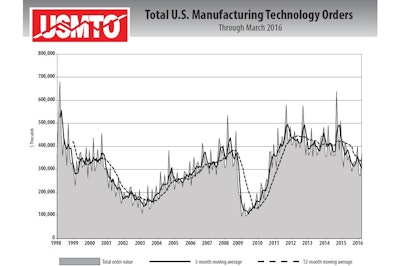
The U.S. Manufacturing Technology Orders report (USMTO) for March 2016 showed that orders grew 36.9 percent compared to the previous month, according to AMT — The Association For Manufacturing Technology. However, orders still were down 11.8 percent compared to March 2015, and stand at 15.0 percent down year-to-date compared to the same point a year ago.
Though the monthly gain appears significant, it is important to note that many manufacturing technology firms close the fiscal year on March 31, which in turn drives activity for orders and sales. Overall, the immediate industry outlook remains flat.
“While dealing with persistent economic challenges and a softer market that’s likely to last into the fourth quarter, manufacturers are leveraging productivity gains to stay competitive,” said AMT President Douglas K. Woods. “The outlook from industry economists improves toward year’s end on two particular strengths of the U.S. economy: foreign direct investment and a resurgent consumer base. For now, manufacturing technology makers are focused on finding markets that offer the best opportunity, like automotive, aerospace and medical. Sentiment among manufacturing executives remains optimistic about future capital equipment investment.”
Other economic data from the manufacturing sector has also been tepid. The ISM PMI came in at a lower-than-expected 50.8 percent for April, and regional Fed surveys for the month were mixed. However, one bright spot was export orders, which rose to a 17-month high.
Regional activity for manufacturing technology orders was particularly strong in the Northeast, much of it driven by activity in the aerospace industry. While the Southeast region saw a monthly drop in orders, it is the only region measured by USMTO that has shown a year-to-date gain in orders compared to 2015, much of it coming from the aerospace and automotive industries.
March 2016 manufacturing technology orders were valued at $370.98 million, compared to $420.79 million in March 2015. Year-to-date orders stand at $922.67 million, compared to $1.09 billion at the same point a year ago.























